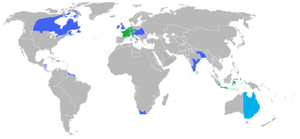War of the Fifth Coalition facts for kids
The War of the Fifth Coalition was a big conflict that happened in 1809. It was fought between two main sides. One side was a group of countries called a "coalition." This group included the Austrian Empire and the United Kingdom. They were fighting against Napoleon's powerful French Empire and its ally, the Kingdom of Bavaria.
The main fighting was between France and Austria. Many important battles took place across a large part of Central Europe. These battles happened from April to July of 1809. Lots of soldiers lost their lives on both sides. In the end, France won the war. This happened after a very important battle called the Battle of Wagram in early July.
Contents
What Was the War of the Fifth Coalition?
This war was part of a bigger series of conflicts known as the Napoleonic Wars. These wars involved Napoleon Bonaparte, who was the emperor of France. He wanted to expand his empire across Europe. Many other European countries tried to stop him. The War of the Fifth Coalition was the fifth time a group of countries teamed up against Napoleon.
Who Fought in This War?
The two main sides in this war were:
- The Coalition: This group was led by the Austrian Empire. They were joined by the United Kingdom. Their goal was to reduce Napoleon's power.
- The French Empire: This side was led by Emperor Napoleon I of France. They were supported by the Kingdom of Bavaria. Bavaria was a German state that was allied with France.
Why Did They Fight?
Austria had been defeated by Napoleon in earlier wars. They wanted to get back some of their lost land and power. They also hoped to encourage other parts of Europe to rise up against French control. The United Kingdom often supported these coalitions. They wanted to stop France from becoming too strong.
Key Battles and How It Ended
The war started in April 1809 when Austria attacked Bavaria, a French ally. Napoleon quickly moved his armies to respond.
Major Fights in Central Europe
Many battles took place in what is now Germany and Austria.
- Battle of Aspern-Essling: In May, Napoleon's army tried to cross the Danube River near Vienna. The Austrian army, led by Archduke Charles, fought them fiercely. This battle was a rare defeat for Napoleon. His forces had to retreat.
- Battle of Wagram: After the defeat at Aspern-Essling, Napoleon gathered a much larger army. In early July, he launched another attack. The Battle of Wagram was one of the biggest battles of the Napoleonic Wars. It involved hundreds of thousands of soldiers. After two days of intense fighting, the French army won a decisive victory.
The Treaty of Schönbrunn
After the Battle of Wagram, Austria had to ask for peace. The war officially ended with the signing of the Treaty of Schönbrunn in October 1809.
- Austria lost a lot of land and people.
- They also had to pay a large amount of money to France.
- This treaty showed that Napoleon was still very powerful in Europe.
Images for kids
-
The strategic situation and the Battle of Aspern-Essling on 22 May 1809.
-
The strategic situation and the Battle of Wagram in early July 1809.
See also
 In Spanish: Quinta Coalición para niños
In Spanish: Quinta Coalición para niños






